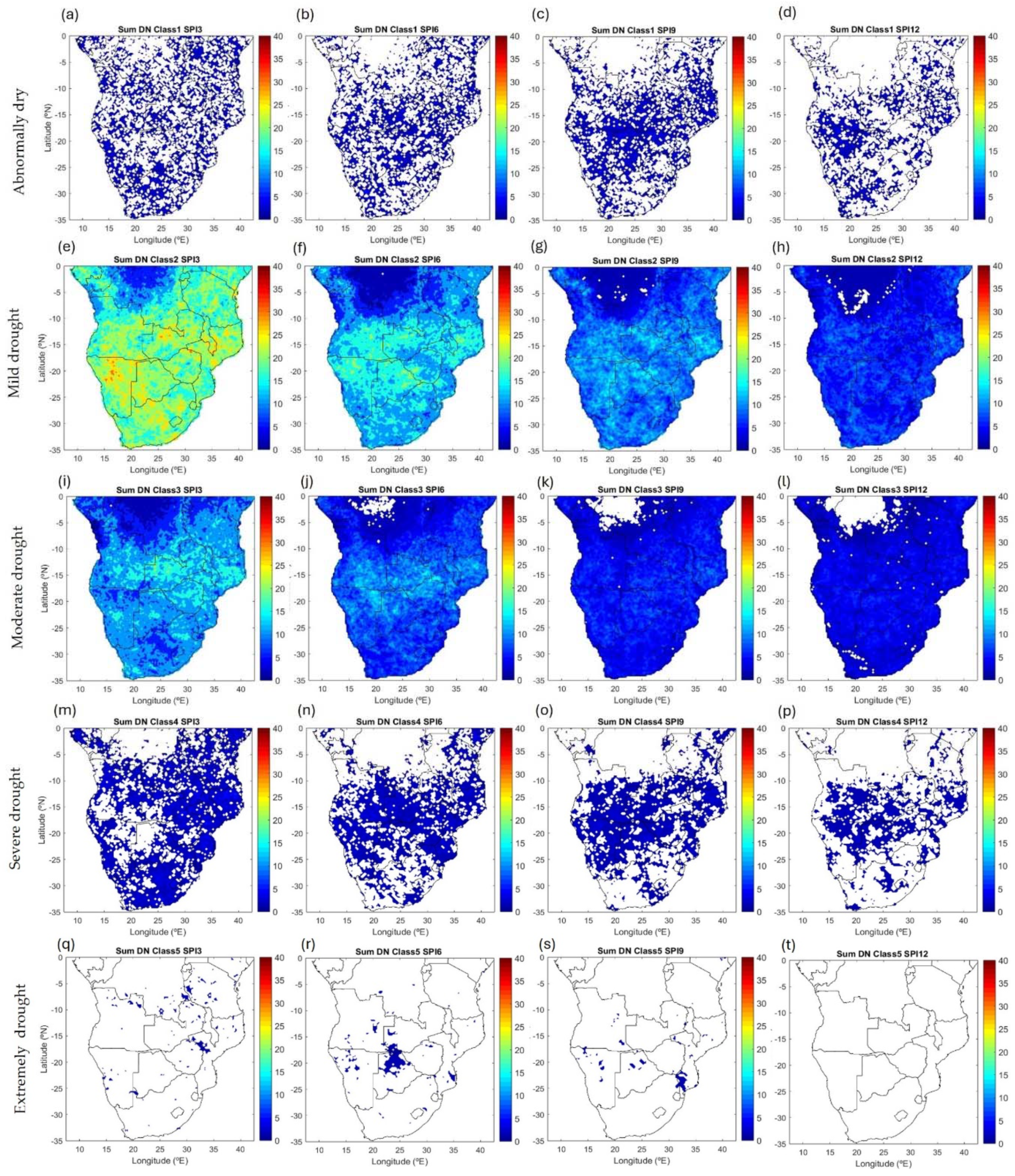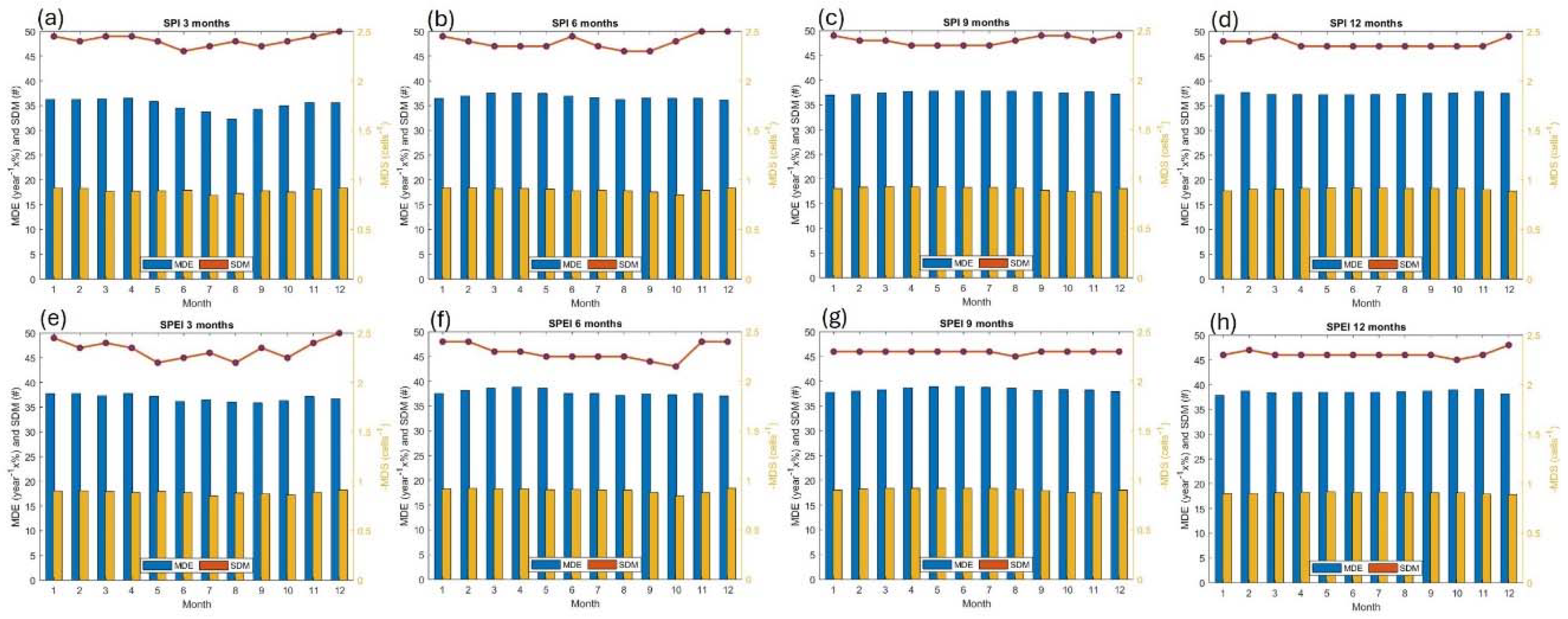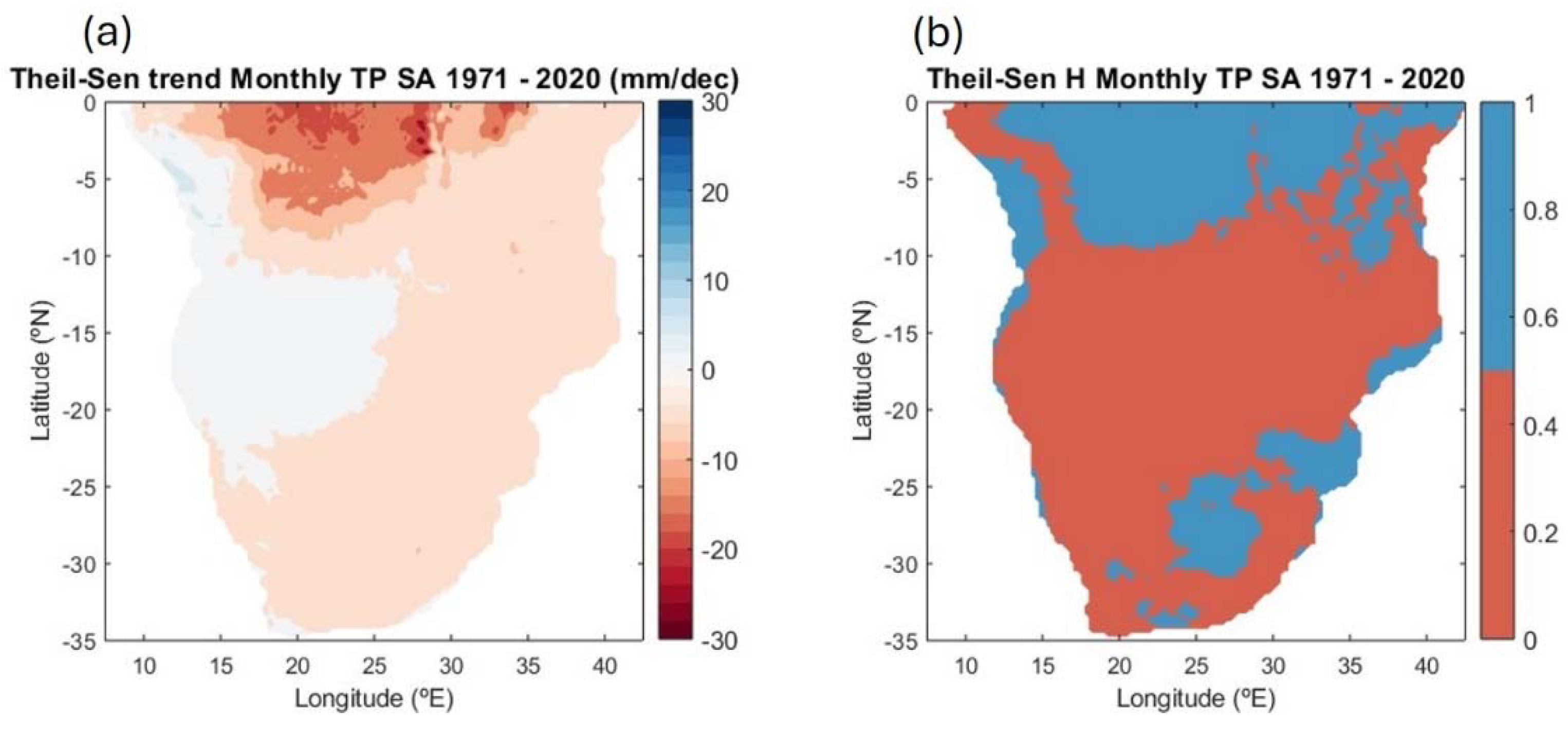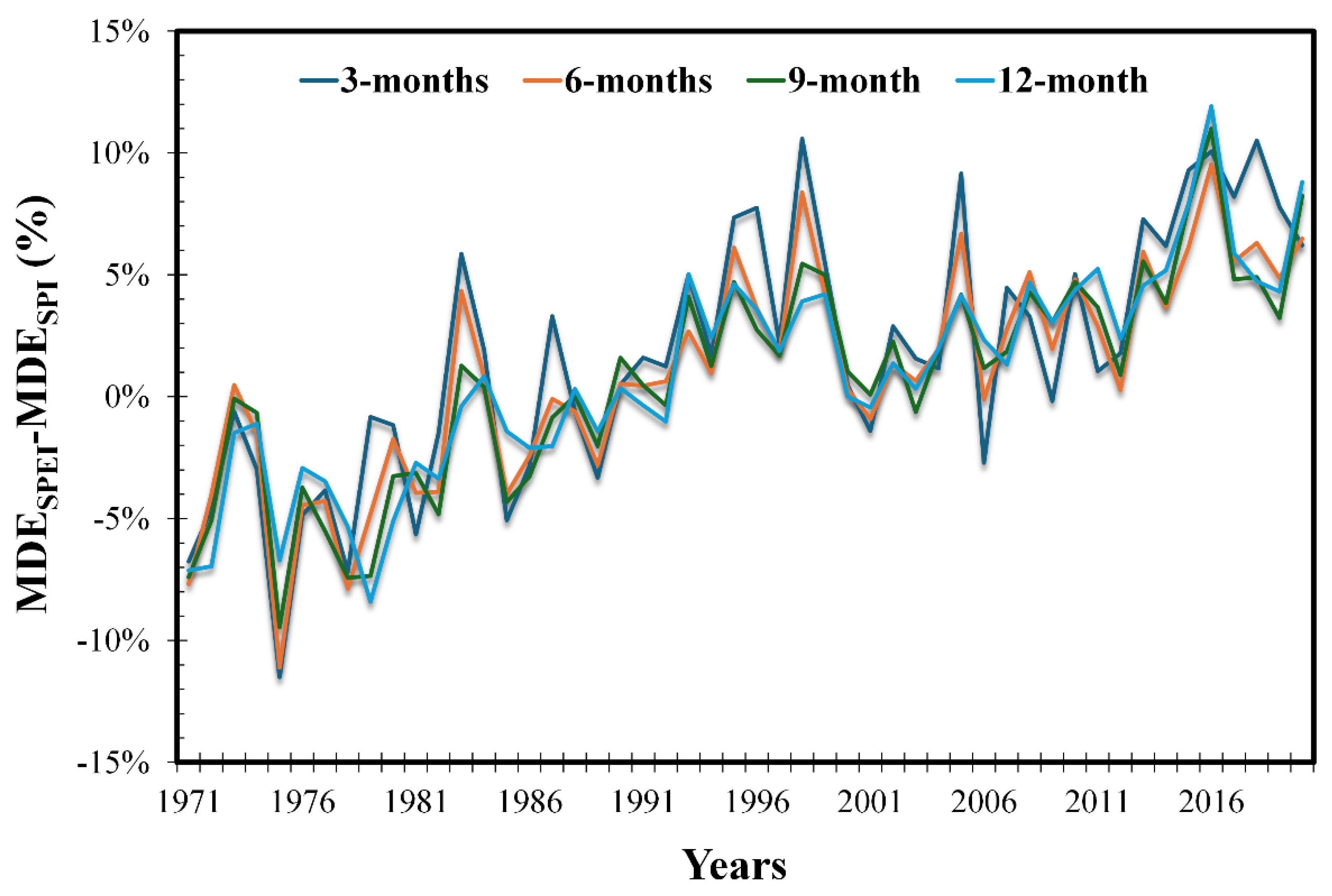Submitted:
02 August 2024
Posted:
05 August 2024
You are already at the latest version
Abstract
Keywords:
1. Introduction
2. Materials and Methods
2.1. Study Area
2.2. Data
- total monthly averages of total precipitation (TP);
- total monthly averages of 10m wind speed (W10m);
- total monthly averages of potential evaporation (PEV);
- land-sea mask;
- geopotential (for altitude calculation Z);
- daily hourly data of the maximum variable temperature of 2m (TMAX2m);
- daily hourly data of 2m minimum temperature (TMIN2m);
- total cloud cover (CC).
2.3. Methods
2.3.1. Meteorological Drought Indices
2.3.2. Drought Occurrence and Characteristics
- The Drought Number (), is defined as the number of droughts in a given location;
- The Drought Duration (), defined as , where is the end month of the drought (the month in which the index returns to being positive) and the start month of the drought (the first month of the drought in which the index is negative);
- The Drought Severity (), defined as the sum of the drought index (e.g., SPI) during the drought, ;
- The Drought Intensity (DI) is the average over its duration, .
2.3.3. Vegetation Index
2.3.4. Other Methods of Applied Statistical Climatology
3. Results
3.1. The Drought Regime in SA
3.1.1. The Spatial Distribution of Drought Descriptors
3.1.2. The Spatial Distribution of Drought Descriptors by Drought Class
3.1.3. Temporal Distribution of Drought Descriptors: The Intra-Annual Distribution
3.1.4. Temporal Distribution of Drought Descriptors: The Interannual Distribution
3.2. Vegetation Conditions during Drought Events
4. Discussion
5. Conclusions
Author Contributions
Funding
Data Availability Statement
Acknowledgements
Conflicts of Interest
Abbreviations
| BAL | Water balance |
| CC | Total cloud cover |
| DC | Drought Class |
| DD | Drought Duration |
| DI | Drought intensity |
| DN | Drought Number |
| DS | Drought severity |
| ECMWF | European Centre for Medium-Range Weather Forecasts |
| EVI | Enhanced Vegetation Index |
| IQR | Inter quartile range |
| MDE | Mean Drought Extent |
| MK | Mann-Kendall |
| NDM | Number Drought Months |
| NDVI | Normalized Difference Vegetation Index |
| NIR | Near-infrared |
| PET | Potential evapotranspiration |
| PEV | Potential evaporation |
| Q | Questions |
| RDC | Democratic Republic of Congo |
| SA | Southern Africa |
| SDE | Sum Drought Extent |
| SPEI | Standardized Precipitation Evapotranspiration |
| SPI | Standardized Precipitation Index |
| SQR | Specific Question Research |
| TMAX2m | Maximum air temperature at 2m |
| TMIN2m | Monimum air temperature at 2m |
| TP | Total precipitation |
| VCI | Vegetation Condition Index |
| W10m | Wind speed and directions at 10m |
| W2m | Wind speed and directions at 10m |
| Z | Altitude |
References
- Wilhite, D.A.; Glantz, M.H. Understanding the Drought Phenomenon : The Role of Definitions. Water Int 1985. [Google Scholar] [CrossRef]
- Wilhite, D.A. Drought as a Natural Hazard: Concepts and Definitions. Drought: A Global Assessment. [CrossRef]
- WMO; GWP Handbook of Drought Indicators and Indices. In Management Tools and Guidelines Series 2. Geneva; (M. Svoboda and B.A., Fuchs)., Ed.; Integrated Drought Management Programme (IDMP), Integrated Drought Management Tools Guidelines Series 2.: Geneva, 2016; Vol. 1, pp. 1068–1069; ISBN 9789263111739. [Google Scholar]
- Schwarz, M.; Landmann, T.; Cornish, N.; Wetzel, K.F.; Siebert, S.; Franke, J. A Spatially Transferable Drought Hazard and Drought Risk Modeling Approach Based on Remote Sensing Data. Remote Sens (Basel) 2020, 12. [Google Scholar] [CrossRef]
- Herrera-Estrada, J.E.; Satoh, Y.; Sheffield, J. Spatiotemporal Dynamics of Global Drought. Geophys Res Lett 2017, 2254–2263. [Google Scholar] [CrossRef]
- Sivakumar Mannava V K; Raymond P Motha; Donald A Wilhite; Deborah A Wood Agricultural Drought Indices. Proceedings of the WMO/UNISDR Expert Group Meeting on Agricultural Drought Indices; (Eds.). 2011.; Murcia, Spain: Geneva, SwitzerlandWorld Meteorological Organization. AGM-11, WMO/TD No. 1572;WAOB-2011. 197 pp., 2011; WMO/TD No. 1572. [Google Scholar]
- Parente, J.; Amraoui, M.; Menezes, I.; Pereira, M.G. Drought in Portugal : Current Regime, Comparison of Indices and Impacts on Extreme Wild Fi Res. Science of the Total Environment 2019, 685, 150–173. [Google Scholar] [CrossRef] [PubMed]
- Wilhite, D.A.; Svoboda, M.D.; Hayes, M.J. Understanding the Complex Impacts of Drought: A Key to Enhancing Drought Mitigation and Preparedness. Water Resources Management 2007, 21, 763–774. [Google Scholar] [CrossRef]
- Wen, Q.; Chen, H. Changes in Drought Characteristics over China during 1961–2019. Front Earth Sci (Lausanne) 2023, 11. [Google Scholar] [CrossRef]
- Hoffmann, D.; Gallant, A.J.E.; Arblaster, J.M. Uncertainties in Drought From Index and Data Selection. Journal of Geophysical Research : Atmospheres 2020, 1–21. [CrossRef]
- Paulo, A.A.; Rosa, R.D.; Pereira, L.S. Climate Trends and Behaviour of Drought Indices Based on Precipitation and Evapotranspiration in Portugal. Natural Hazards and Earth System Sciences 2012, 12, 1481–1491. [Google Scholar] [CrossRef]
- Chivangulula, F.M.; Amraoui, M.; Pereira, M.G. The Drought Regime in Southern Africa: A Systematic Review. Climate 2023, 11. [Google Scholar] [CrossRef]
- Palmer Wayne, C. Meteorological Drought. Office of Climatology U.S. Weather Bureau, Washington, DC, 1965. [Google Scholar]
- Mishra, A.K.; Singh, V.P. A Review of Drought Concepts. J Hydrol (Amst) 2010, 391, 202–216. [Google Scholar] [CrossRef]
- Ramirez, S.G.; Hales, R.C.; Williams, G.P.; Jones, N.L. Extending SC-PDSI-PM with Neural Network Regression Using GLDAS Data and Permutation Feature Importance. Environmental Modelling and Software 2022, 157, 105475. [Google Scholar] [CrossRef]
- Mckee, T.B.; Doesken, N.J.; Kleist, J. The Relationship of Drought Frequency and Duration to Time Scales. Eighth Conference on Applied Climatology 1993, 17–22. [Google Scholar]
- Vicente-Serrano, S.M.; Beguería, S.; López-Moreno, J.I. A Multiscalar Drought Index Sensitive to Global Warming: The Standardized Precipitation Evapotranspiration Index. J Clim 2010, 23, 1696–1718. [Google Scholar] [CrossRef]
- Kamble, D.B.; Gautam, S.; Bisht, H.; Rawat, S.; Kundu, A. Drought Assessment for Kharif Rice Using Standardized Precipitation Index (SPI) and Vegetation Condition Index (VCI). Journal of Agrometeorology 2019, 21, 182–187. [Google Scholar] [CrossRef]
- Weier, J.; Herring, D. Medição Da Vegetação (NDVI & EVI). Available online: https://earthobservatory.nasa.gov/features/MeasuringVegetation/measuring_vegetation_4.php (accessed on 29 March 2022).
- WMO WMO Atlas of Mortality and Economic Losses From Weather, Climate and Water Extremes (1970-2019); Weather Climate Water, 2021; ISBN 9789263112675.
- Nhamo, L.; Mabhaudhi, T.; Modi, A.T. Preparedness or Repeated Short-Term Relief Aid? Building Drought Resilience through Early Warning in Southern Africa. Water SA 2019, 45, 75–85. [Google Scholar] [CrossRef]
- Orimoloye, I.R.; Belle, J.A.; Orimoloye, Y.M.; Olusola, A.O.; Ololade, O.O. Drought: A Common Environmental Disaster. Atmosphere (Basel) 2022, 13. [Google Scholar] [CrossRef]
- Funk, C.; Harrison, L.; Shukla, S.; Hoell, A.; Korecha, D.; Magadzire, T.; Husak, G.; Galu, G. Assessing the Contributions of Local and East Pacific Warming to the 2015 Droughts in Ethiopia and Southern Africa. In Explaining Extreme Events of 2015; Herring, S.C., Hoell, A., Hoerling, M.P., Kossin, J.P., III, C.J.S., Stott, P.A., Eds.; Explaining extreme events of 2015 from a climate perspective. Special Supplement to the Bulletin of the American Meteorological Society/Vol. 97, No. 12, (pp. S75-S80)., 2016; p. 75.
- Sifundza, L.; Zaag, P. van der; Masih, I. Evaluation of the Responses of Institutions and Actors to the 2015 / 2016 El Niño Drought in the Komati Catchment in Southern Africa : Lessons to Support Future Drought Management. Water SA 2019, 45, 547–559. [Google Scholar] [CrossRef]
- Toreti, A.; Bavera, D.; Navarro, A.; Acquafresca, J.; Asega, L.; Barbosa, C.; Collivignarelli, P.; De Jager, W.S.; Fioravanti, A.; Grimaldi, G.; et al. Joint Research Centre (JRC). 2024.
- Khan, M.Z.K.; Rahman, A.; Rahman, M.A.; Renzaho, A.M.N. Impact of Droughts on Child Mortality: A Case Study in Southern African Countries. Natural Hazards 2021, 108, 2211–2224. [Google Scholar] [CrossRef]
- Ujeneza, E.L.; Abiodun, B.J. Drought Regimes in Southern Africa and How Well GCMs Simulate Them. Springer 2015, 1595–1609. [Google Scholar] [CrossRef]
- Yuan, X.; Wang, L.; Wood, E.F. Anthropogenic Intensification of Southern African Flash Droughts as Exemplified by the 2015/16 Season. Bull Am Meteorol Soc 2018, 99, S86–S90. [Google Scholar] [CrossRef]
- Kottek, M.; Grieser, J.; Beck, C.; Rudolf, B.; Rubel, F. World Map of the Köppen-Geiger Climate Classification Updated. Meteorologische Zeitschrift 2006, 15, 259–263. [Google Scholar] [CrossRef] [PubMed]
- Miranda, P.M.A. Meteorologia e Ambiente:Fundamentos de Meteorologia; Clima e Ambiente Atmosférico.; Aberta.1269-001Lisboa-Portugal, U., Ed.; 2o Edição.; 2009; ISBN 978-972-674-655-3.
- Peel, M.C.; Finlayson, B.L.; Mcmahon, T.A. Updated World Map of the K ¨ Oppen-Geiger Climate Classification. Hydrol Earth Syst Sci 2007, 1633–1644. [Google Scholar] [CrossRef]
- Abiodun, B.J.; Makhanya, N.; Abatan, A.; Oguntunde, P.G. Future Projection of Droughts over Major River Basins in Southern Africa at Specific Global Warming Levels. Springer 2019. [Google Scholar] [CrossRef]
- Mupangwa, W.; Chipindu, L.; Ncube, B.; Mkuhlani, S.; Nhantumbo, N.; Masvaya, E.; Ngwira, A.; Moeletsi, M.; Nyagumbo, I.; Liben, F. Temporal Changes in Minimum and Maximum Temperatures at Selected Locations of Southern Africa. Climate 2023, 11. [Google Scholar] [CrossRef]
- Geppert, M.; Hartmann, K.; Kirchner, I.; Pfahl, S.; Struck, U.; Riedel, F. Precipitation Over Southern Africa: Moisture Sources and Isotopic Composition. Journal of Geophysical Research: Atmospheres 2022, 127. [Google Scholar] [CrossRef]
- Olson, D.M.; Dinerstein, E.; Wikramanayake, E.D.; Burgess, N.D.; Powell, G.V.N.; Underwood, E.C.; D’Amico, J.A.; Itoua, I.; Strand, H.E.; Morrison, J.C.; et al. Terrestrial Ecoregions of the World: A New Map of Life on Earth. Bioscience. Bioscience 2001, 51. [Google Scholar] [CrossRef]
- Hersbach, H.; Bell, B.; Berrisford, P.; Biavati, G.; Horányi, A.; Muñoz Sabater, J.; Nicolas, J.; Peubey, C.; Radu, R.; Rozum, I.; et al. ERA5 Hourly Data on Single Levels from 1940 to Present Available online: https://cds.climate.copernicus.eu/cdsapp#!/dataset/reanalysis-era5-single-levels?tab=form (accessed on 15 May 2024).
- Hersbach, H.; Bell, B.; Berrisford, P.; Biavati, G.; Horányi, A.; Muñoz Sabater, J.; Nicolas, J.; Peubey, C.; Radu, R.; Rozum, I.; et al. ERA5 Monthly Averaged Data on Single Levels from 1940 to Present Available online: 1024381/cds.f17050d7 (accessed on 20 May 2024).
- Allen, R.G.; Pereira, L.S.; Raes Dirk; Smith Martin Crop Evapotranspiration-Guidelines for Computing Crop Water Requirements; FAO Irrigation and Drainage Paper, 1998.
- Didan, K. MOD13A3 MODIS/Terra Vegetation Indices Monthly L3 Global 1km SIN Grid V006 (Data Set) NASA EOSDIS Land Process; 2015.
- Didan, K. MOD13A3 MODIS/Terra Vegetation Indices Monthly L3 Global 1km SIN Grid V006 (Data Set) NASA EOSDIS Land Process; 2015.
- Zhao, H.; Gao, G.; An, W.; Zou, X.; Li, H.; Hou, M. Timescale Differences between SC-PDSI and SPEI for Drought Monitoring in China. Physics and Chemistry of the Earth 2017, 102, 48–58. [Google Scholar] [CrossRef]
- Keyantash, J. ; National Center for Atmospheric Research Staff NCAR. Available online: https://climatedataguide.ucar.edu/climate-data/standardized-precipitation-index-spi (accessed on 29 February 2024).
- Farahmand, A.; AghaKouchak, A. A Generalized Framework for Deriving Nonparametric Standardized Drought Indicators. Adv Water Resour 2015, 76, 140–145. [Google Scholar] [CrossRef]
- Hao, Z.; AghaKouchak, A.; Nakhjiri, N.; Farahmand, A. Global Integrated Drought Monitoring and Prediction System. Sci Data 2014, 1, 140001. [Google Scholar] [CrossRef]
- Wang, Q.; Zeng, J.; Qi, J.; Zhang, X.; Zeng, Y.; Shui, W.; Xu, Z.; Zhang, R.; Wu, X.; Cong, J. A Multi-Scale Daily SPEI Dataset for Drought Characterization at Observation Stations over Mainland China from 1961 to 2018. Earth Syst Sci Data 2021, 13, 331–341. [Google Scholar] [CrossRef]
- Uml, M.J.; Kim, Y.; Park, D.; Kim, J. Effects of Different Reference Periods on Drought Index (SPEI) Estimations from 1901 to 2014. Hydrol Earth Syst Sci 2017, 21, 4989–5007. [Google Scholar] [CrossRef]
- Ali, Z.; Hussain, I.; Faisal, M.; Almanjahie, I.M.; Ahmad, I.; Khan, D.M.; Grzegorczyk, M.; Qamar, S. A Probabilistic Weighted Joint Aggregative Drought Index (PWJADI) Criterion for Drought Monitoring Systems. Tellus, Series A: Dynamic Meteorology and Oceanography 2019, 71, 1–21. [Google Scholar] [CrossRef]
- Rhee, J.; Cho, J. Future Changes in Drought Characteristics: Regional Analysis for South Korea under CMIP5 Projections. J Hydrometeorol 2016, 17, 437–451. [Google Scholar] [CrossRef]
- Vicente-Serrano; Sergio M.; National Center for Atmospheric Research Staff (Eds) Vicente Serrano e NCAR. Available online: https://climatedataguide.ucar.edu/climate-data/standardized-precipitation-evapotranspiration-index-spei on 2024-02-29. (accessed on 29 February 2024).
- Gad, H.; El-Gayar, S.M. Climate Parameters Used to Evaluate the Evapotranspiration in Delta Central Zone of Egypt. Fourteenth International Water Technology Conference 2010.
- Subedi, A.; Chávez, J.L. Crop Evapotranspiration (ET) Estimation Models: A Review and Discussion of the Applicability and Limitations of ET Methods. Journal of Agricultural Science 2015, 7. [Google Scholar] [CrossRef]
- Howell, T.A.; Evett, S. The Penman-Monteith Method. USDA-Agricultural Research Service Conservation & Production Research Laboratory 2004.
- Xu, C.; Wang, W.; Hu, Y.; Liu, Y. Evaluation of ERA5, ERA5-Land, GLDAS-2.1, and GLEAM Potential Evapotranspiration Data over Mainland China. J Hydrol Reg Stud 2024, 51. [Google Scholar] [CrossRef]
- Ali, S.; Basit, A.; Umair, M.; Makanda, T.A.; Shaik, M.R.; Ibrahim, M.; Ni, J. The Role of Climate Change and Its Sensitivity on Long-Term Standardized Precipitation Evapotranspiration Index, Vegetation and Drought Changing Trends over East Asia. Plants 2024, 13. [Google Scholar] [CrossRef] [PubMed]
- Singh, O.; Saini, D.; Bhardwaj, P. Characterization of Meteorological Drought over a Dryland Ecosystem in North Western India. Springer 2021, 109, 785–826. [Google Scholar] [CrossRef]
- Carlson, T.N.; Ripley, D.A. On the Relation between NDVI, Fractional Vegetation Cover, and Leaf Area Index. Remote Sens Environ 1997, 62, 241–252. [Google Scholar] [CrossRef]
- Heath, J.T.; Chafer, C.J.; Bishop, T.F.A.; van Ogtrop, F.F. Post-Fire Recovery of Eucalypt-Dominated Vegetation Communities in the Sydney Basin, Australia. Fire Ecology 2016, 12, 53–79. [Google Scholar] [CrossRef]
- Yamamoto, H.; Miura, T.; Tsuchida, S. Advanced Spaceborne Thermal Emission and Reflection Radometer (ASTER) Enhanced Vegetation Index (EVI) Products from Global Earth Observation (GEO) Grid: An Assessment Using Moderate Resolution Imaging Spectroradiometer (MODIS) for Synergistic Applications. Remote Sens (Basel) 2012, 4, 2277–2293. [Google Scholar] [CrossRef]
- Moreira, A.A.; Guasselli, L.A.; Silva Filho, L.C.P.; Andrade, A.C.F.; Arruda, D.C. de Índice de Condição Da Vegetação (VCI) Para Mapeamento de Seca No Norte Do Estado de Minas Gerais. Anais XVII Simpósio Brasileiro de Sensoriamento Remoto - SBSR, João Pessoa-PB, Brasil, 25 a 29 de abril de 2015, INPE 2015, 1686–1692.
- Gocic, M.; Trajkovic, S. Analysis of Changes in Meteorological Variables Using Mann-Kendall and Sen’s Slope Estimator Statistical Tests in Serbia. Glob Planet Change 2013, 100, 172–182. [Google Scholar] [CrossRef]
- Marsick, A.; André, H.; Khelf, I.; Leclère, Q.; Antoni, J. Benefits of Mann–Kendall Trend Analysis for Vibration-Based Condition Monitoring. Mech Syst Signal Process 2024, 216. [Google Scholar] [CrossRef]
- Vannest, K.J.; Parker, R.I.; Davis, J.L.; Soares, D.A.; Smith, S.L. The Theil-Sen Slope for High-Stakes Decisions from Progress Monitoring; 2012.
- Pereira, M.G.; Trigo, R.M.; Da Camara, C.C.; Pereira, J.M.C.; Leite, S.M. Synoptic Patterns Associated with Large Summer Forest Fires in Portugal. Agric For Meteorol 2005, 129, 11–25. [Google Scholar] [CrossRef]
- Pereira, M.G.; Gonçalves, N.; Amraoui, M. The Influence of Wildfire Climate on Wildfire Incidence: The Case of Portugal. Fire 2024, 7, 234. [Google Scholar] [CrossRef]
- Amraoui, M.; Pereira, M.G.; DaCamara, C.C.; Calado, T.J. Atmospheric Conditions Associated with Extreme Fire Activity in the Western Mediterranean Region. Science of the Total Environment 2015, 524–525, 32–39. [Google Scholar] [CrossRef] [PubMed]
- Parente, J.; Pereira, M.G.; Tonini, M. Space-Time Clustering Analysis of Wildfires: The Influence of Dataset Characteristics, Fire Prevention Policy Decisions, Weather and Climate. Science of the Total Environment 2016, 559, 151–165. [Google Scholar] [CrossRef] [PubMed]
- Trambauer, P.; Werner, M.; Winsemius, H.C.; Maskey, S.; Dutra, E.; Uhlenbrook, S. Hydrological Drought Forecasting and Skill Assessment for the Limpopo River Basin, Southern Africa. Hydrol Earth Syst Sci 2015, 19, 1695–1711. [Google Scholar] [CrossRef]
- Vogel, C.; Koch, I.; Van Zyl, K. “A Persistent Truth”-Reflections on Drought Risk Management in Southern Africa. Weather, Climate, and Society 2010, 2, 9–22. [Google Scholar] [CrossRef]
- Mateus, N.P.A.; Marengo, J.A.; Cunha, A.P.M.A.; Diogo, A.M.; António, J.F. Spatial–Temporal Characterization of Droughts in Angola. International Journal of Climatology 2024, 44, 370–392. [Google Scholar] [CrossRef]
- Limones, N.; Marzo-artigas, J.; Wijnen, M. Evaluating Drought Risk in Data-Scarce Contexts. The Case of Southern Angola. Journal of Water and Climate Change 2020. [Google Scholar] [CrossRef]
- Kamara, J.K.; Sahle, B.W.; Agho, K.E.; Renzaho, A.M.N. Governments’ Policy Response to Drought in Eswatini and Lesotho: A Systematic Review of the Characteristics, Comprehensiveness, and Quality of Existing Policies to Improve Community Resilience to Drought Hazards. Discrete Dyn Nat Soc 2020, 2020. [Google Scholar] [CrossRef]
- Moreira E E; Martins D. S.; Pereira L. S. Assessing Drought Cycles in SPI Time Series Using a Fourier Analysis. Natural Hazards and Earth System Sciences 2015, 15, 571–585. [Google Scholar] [CrossRef]
- Dutta, D.; Kundu, A.; Patel, N.R.; Saha, S.K.; Siddiqui, A.R. Assessment of Agricultural Drought in Rajasthan (India) Using Remote Sensing Derived Vegetation Condition Index (VCI) and Standardized Precipitation Index (SPI). Egyptian Journal of Remote Sensing and Space Science 2015, 18, 53–63. [Google Scholar] [CrossRef]
- Cunha, A.P.M.A.; Zeri, M.; Leal, K.D.; Costa, L.; Cuartas, L.A.; Marengo, J.A.; Tomasella, J.; Vieira, R.M.; Barbosa, A.A.; Cunningham, C.; et al. Extreme Drought Events over Brazil from 2011 to 2019. Atmosphere (Basel) 2019, 10. [Google Scholar] [CrossRef]
- Tuan, N. Van; Hieu, N. Van; Bang, N.K.; Hai, P.H.; Van, N.K.; Ha, L.V.; Hoa, T.T.; Hiếu, L.T. Spatio-Temporal Analysis of Drought in the North-Eastern Coastal Region of Vietnam Using the Standardized Precipitation Index (SPI). Atmospheric and Climate Sciences 2023, 13, 175–200. [Google Scholar] [CrossRef]
- Nooni, I.K.; Hagan, D.F.T.; Ullah, W.; Lu, J.; Li, S.; Prempeh, N.A.; Gnitou, G.T.; Sian, K.T.C.L.K. Projections of Drought Characteristics Based on the CNRM-CM6 Model over Africa. Agriculture (Switzerland) 2022, 12, 1–19. [Google Scholar] [CrossRef]
- Rouault, M.; Richard, Y. Intensity and Spatial Extent of Droughts in Southern Africa. Geophys Res Lett 2005, 32, 2–5. [Google Scholar] [CrossRef]
- Jury, M.R. Climate Trends in Southern Africa. S Afr J Sci 2013, 109, 1–11. [Google Scholar] [CrossRef]
- Tyson, P.D.; Cooper, G.R.J.; McCarthy, T.S. Millennial to Multi-Decadal Variability in the Climate of Southern Africa. International Journal of Climatology 2002, 22, 1105–1117. [Google Scholar] [CrossRef]
- Lawal, S.; Hewitson, B.; Egbebiyi, T.S.; Adesuyi, A. On the Suitability of Using Vegetation Indices to Monitor the Response of Africa’s Terrestrial Ecoregions to Drought. Science of the Total Environment 2021, 792. [Google Scholar] [CrossRef] [PubMed]
- Wilhite D; Sivakumar M; Wood D; Ambeje P. G. Early Warning Systems for Drought Preparedness and Drought Management.; Proceedings of an Expert Group Meeting held in Lisbon, Portugal,.World Meteorological Organization.: Lisbon, Portugal, 2000; ISBN 2013206534. [Google Scholar]
- Zeidler, J.; Chunga, R. Drought Hazard and Land Management in the Drylands of Southern Africa. In Climate and Land Degradation; K.Sivakumar·, M. V., NdegwaNdiang’ui, Eds.; Tanzania Meteorological Agency (TMA) United NationsConventiontoCombatDesertification (UNCCD) WorldMeteorologicalOrganization (WMO), 2007; p. 309 ISBN 9783540724377.
- Lyon, B. Southern Africa Summer Drought and Heat Waves: Observations and Coupled Model Behavior. J Clim 2009, 22, 6033–6046. [Google Scholar] [CrossRef]
- Mtilatila, L.; Bronstert, A.; Bürger, G.; Vormoor, K. Meteorological and Hydrological Drought Assessment in Lake Malawi and Shire River Basins (1970–2013). Hydrological Sciences Journal 2020, 65, 2750–2764. [Google Scholar] [CrossRef]
- Wardlow, B.D..; Anderson, M.C..; Verdin, J.P.. Innovative Monitoring Approaches. In; Wilhete Donald A, Ed.; Remote Sensing of Drought: Boca Raton London New York, 2012; p. 422 ISBN 9781439835609.
- Fraga, H.; Amraoui, M.; Malheiro, A.C.; Moutinho-Pereira, J.; Eiras-Dias, J.; Silvestre, J.; Santos, J.A. Examining the Relationship between the Enhanced Vegetation Index and Grapevine Phenology. Eur J Remote Sens 2014, 47, 753–771. [Google Scholar] [CrossRef]
- Huete, A.; Didan, K.; Miura, T.; Rodriguez, E.P.; Gao, X.; Ferreira, L.G. Overview of the Radiometric and Biophysical Performance of the MODIS Vegetation Indices. Remote Sens Environ 2002, 195–213. [Google Scholar] [CrossRef]
- Vicente-Serrano, S.M.; Gouveia, C.; Camarero, J.J.; Beguería, S.; Trigo, R.; López-Moreno, J.I.; Azorín-Molina, C.; Pasho, E.; Lorenzo-Lacruz, J.; Revuelto, J.; et al. Response of Vegetation to Drought Time-Scales across Global Land Biomes. Proc Natl Acad Sci U S A 2013, 110, 52–57. [Google Scholar] [CrossRef] [PubMed]
- Páscoa, P.; Gouveia, C.M.; Russo, A.C.; Bojariu, R.; Vicente-Serrano, S.M.; Trigo, R.M. Drought Impacts on Vegetation in Southeastern Europe. Remote Sens (Basel) 2020, 12. [Google Scholar] [CrossRef]
- Gouveia, C.M.; Trigo, R.M.; Beguería, S.; Vicente-Serrano, S.M. Drought Impacts on Vegetation Activity in the Mediterranean Region: An Assessment Using Remote Sensing Data and Multi-Scale Drought Indicators. Glob Planet Change 2017, 151, 15–27. [Google Scholar] [CrossRef]
- Ding, Y.; Xu, J.; Wang, X.; Peng, X.; Cai, H. Spatial and Temporal Effects of Drought on Chinese Vegetation under Different Coverage Levels. Science of the Total Environment 2020, 716. [Google Scholar] [CrossRef] [PubMed]
- Ji, L.; Peters, A.J. Assessing Vegetation Response to Drought in the Northern Great Plains Using Vegetation and Drought Indices. Remote Sens Environ 2003, 87, 85–98. [Google Scholar] [CrossRef]
- Lawal, S.; Lennard, C.; Jack, C.; Wolski, P.; Hewitson, B. The Observed and Model-Simulated Response of Southern African Vegetation to Drought. Agric For Meteorol 2019, 279, 107698. [Google Scholar] [CrossRef]
- Verhoeve, S.L.; Keijzer, T.; Kaitila, R.; Wickama, J.; Sterk, G. Vegetation Resilience under Increasing Drought Conditions in Northern Tanzania. Remote Sens (Basel) 2021, 13. [Google Scholar] [CrossRef]
- Alahacoon, N.; Edirisinghe, M. A Comprehensive Assessment of Remote Sensing and Traditional Based Drought Monitoring Indices at Global and Regional Scale. Geomatics, Natural Hazards and Risk 2022, 13, 762–799. [Google Scholar] [CrossRef]
- Nieves, A.; Contreras, J.; Pacheco, J.; Urgilés, J.; García, F.; Avilés, A. Assessment of Drought Time-Frequency Relationships with Local Atmospheric-Land Conditions and Large-Scale Climatic Factors in a Tropical Andean Basin. Remote Sens Appl 2022, 26. [Google Scholar] [CrossRef]
- Zhou, K.; Li, J.; Zhang, T.; Kang, A. The Use of Combined Soil Moisture Data to Characterize Agricultural Drought Conditions and the Relationship among Different Drought Types in China. Agric Water Manag 2021, 243. [Google Scholar] [CrossRef]













Disclaimer/Publisher’s Note: The statements, opinions and data contained in all publications are solely those of the individual author(s) and contributor(s) and not of MDPI and/or the editor(s). MDPI and/or the editor(s) disclaim responsibility for any injury to people or property resulting from any ideas, methods, instructions or products referred to in the content. |
© 2024 by the authors. Licensee MDPI, Basel, Switzerland. This article is an open access article distributed under the terms and conditions of the Creative Commons Attribution (CC BY) license (http://creativecommons.org/licenses/by/4.0/).





